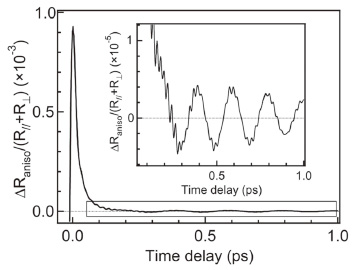Optical Science Laboratory
Single-walled carbon nanotubes (SWCNT) become either metallic or semiconducting
depending on their structure (i.e., chirality). Metallic SWCNTs exhibit
ballistic transport due to their quasi-one-dimensional structure. However,
electron scattering by optical phonons sets the ultimate limit for high
field ballistic transport. To employ metallic SWCNTs as future electronic
devices, we must understand the phonon to allow us quantify the interaction
between carriers and phonons. Ultrashort laser pulses, whose pulse duration
is shorter than the lattice vibration period, make it possible to achieve
the real-time observation of lattice oscillation, that is, coherent phonons.
Most SWCNTs contain a broad distribution of chiralities. Thus, it is difficult
to obtain detailed information or control SWCNTs with a specific chirality
because SWCNTs with different chiralities are excited simultaneously in
a mixed sample. By using a separation scheme [1], we are able to report
ultrafast carrier and coherent phonon dynamics in metallic SWCNTs [2].
Time-resolved reflectivity was measured with a sub-10-fs laser pulse,
whose wavelength was centered on 780 nm. Figure 1 shows the time-resolved
reflectivity of metallic SWCNTs. At a zero delay-time, a sharp response
originating from the excitation of free carriers appears and decays within
30 fs through carrier-carrier scattering. Then, an oscillatory signal,
induced with coherent phonons, follows the carrier response (inset in Fig.
1). A Fourier transform analysis reveals that the oscillation originates
from coherent phonons of (i) the radial breathing mode, (iii) the G mode,
and (ii) even the D mode, which originates from defects in SWCNTs (Fig.
2). The G mode consists of several peaks corresponding to the transverse
and longitudinal optical phonon modes for the peaks with the higher and
lower frequencies, respectively. The longitudinal phonon exhibits an asymmetric
shape due to the interaction between coherent phonons and free carriers.
With the separation of metallic SWCNTs from the mixed sample, we identified
ultrafast dynamics of free carriers and the electron-phonon coupling.
This work was partly supported by KAKENHI.
[1] K. Yanagi et al., Appl. Phys. Express 1 (2008) 034003.
[2] K. Kato et al., Appl. Phys. Lett. 97 (2010) 121910.
 |
 |
|||||
|
|